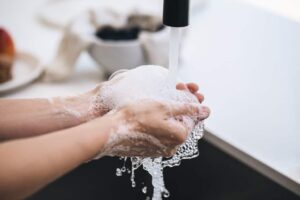There’s always been an emphasis on washing hands – you’ve heard it from your parents, from your middle school health teacher, from the employee posters on the wall in restaurant bathrooms. However, many are unaware of its extreme importance, and how effective it truly is in preventing illness and disease. Handwashing helps protect yourself and others from getting sick and is a key factor in helping to stop pandemics, like the recent wave of coronavirus. Despite being taught how hand washing is beneficial, most people don’t know how to wash their hands correctly. Look below for a guide on how to do so.
Why You Should Wash Your Hands
According to Centers for Disease Control and Prevention (CDC), proper handwashing can help prevent the passing of infections and germs between people. Using water and antibacterial soap mostly eliminates germs from your hands. This is significant because people often touch their eyes, faces, and mouths, which are the primary orifices through which germs get into the body. Additionally, there are many customs throughout the world that have people touching each other’s hands, like a handshake as a greeting, which can lead to the spread of germs. If a person doesn’t practice proper handwashing, they can also pass along germs through the objects they touch, like handrails, door handles, etc.
Historically, the introduction of handwashing has helped decrease the number of people who get sick with respiratory issues and gastrointestinal illness, especially in more susceptible populations like children. Hand washing can also aid in fighting antibiotic resistance. If there are fewer infections, there will be fewer antibiotics prescribed.
How to Properly Wash Your Hands
- Turn on the faucet, wet your hands, turn off the faucet. You can use any temperature of water. There have been no significant studies that prove warm water is more effective in removing germs while hand washing, which is a huge plus for those whose skin may be irritated by hot water. By turning off the faucet, you’ll save water.
- Apply soap to your hands, lathering all over, including under your fingernails, and scrub for at least 20 seconds. It may seem counterintuitive to turn off the faucet and touch it again to turn it on, but there is no information that there is a significant amount of germs transferred between faucets and hands. Lathering and scrubbing with soap is one of the most important steps while washing your hands. It is much more effective in killing germs versus just washing your hands with water, and the friction helps pick up any microbes or foreign substances (like dirt) that can be on your skin. The ideal time for scrubbing is 20 seconds. If you have a hard time singing, you can think or hum the alphabet song twice.
- Rinse with clean water. After you’re done, turn off the faucet. This will ensure that you get all of the soap off your hands. If there is any leftover residue, it could cause potential skin irritation. Although many people in the past have recommended using a paper towel to touch the faucet and turn it off, there is no evidence that supports that this is an accurate safety measure against germs. Instead, it can lead to paper towel waste.
- Dry your hands. To dry your hands, use either a clean towel or air dry them. Studies that examine the benefits of using hand dryers are lacking, so as of now, a clean towel or air drying is the best method.
When and how to use hand sanitizer
Hand sanitizer is not interchangeable for hand washing. According to the CDC, soap and water is capable of eliminating more germs than hand sanitizer. Additionally, hand sanitizer is less effective when hands are visibly dirty (think dirt, oil, grease, etc.) However, if soap and water aren’t available, hand sanitizer is better than nothing.
A person should use a hand sanitizer that is made up of at least 60% alcohol. Typically, only a small amount is needed, but the label on the bottle will specify how much a person should use. Squeeze a dollop onto one palm and then rub your hands together until both hands are covered and dry.
Overall…
There are many misconceptions about how to properly wash your hands. Clearly, correct handwashing is especially important during flu seasons (look at Stability Healthcare’s blog post about Coronavirus here), but the main priority is to always practice the right way of handwashing.
As a reminder, Stability Healthcare offers multiple healthcare plans when you’re a travel nurse. The best way to not get sick is to use prevention methods, like hand washing or using hand sanitizer in cases when you’re not able to use soap and water. Keep in mind that you’re not just keeping yourself safe, but you’re keeping others safe too!





